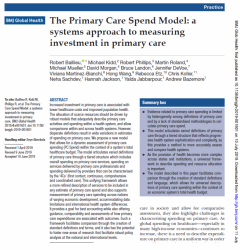
ABSTRACT
Increased investment in primary care is associated with lower healthcare costs and improved population health. The allocation of scarce resources should be driven by robust models that adequately describe primary care activities and spending within a health system, and allow comparisons within and across health systems. However, disparate definitions result in wide variations in estimates of spending on primary care. We propose a new model that allows for a dynamic assessment of primary care spending (PC Spend) within the context of a system’s total healthcare budget. The model articulates varied definitions of primary care through a tiered structure which includes overall spending on primary care services, spending on services delivered by primary care professionals and spending delivered by providers that can be characterised by the ‘4Cs’ (first contact, continuous, comprehensive and coordinated care). This unifying framework allows a more refined description of services to be included in any estimate of primary care spend and also supports measurement of primary care spending across nations of varying economic development, accommodating data limitations and international health system differences. It provides a goal for best accounting while also offering guidance, comparability and assessments of how primary care expenditures are associated with outcomes. Such a framework facilitates comparison through the creation of
standard definitions and terms, and it also has the potential to foster new areas of research that facilitate robust policy analysis at the national and international levels.
| Attachment | Size |
|---|---|
| 1.44 MB |

